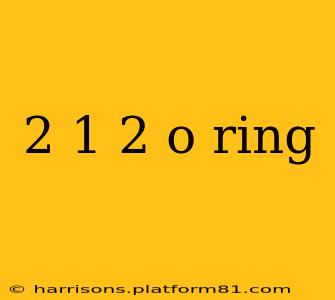Decoding the Mystery of the "2 1 2 O-Ring"
The term "2 1 2 O-ring" is not a standard industry designation. It's likely a shorthand description referring to an o-ring's dimensions or a specific part number within a particular system. To understand what a "2 1 2 O-ring" actually is, we need more context. This ambiguity highlights the importance of precise terminology when dealing with critical components like o-rings, which often play vital roles in sealing and preventing leaks in various applications.
Let's explore some possibilities and delve into the information needed to properly identify an o-ring:
What does "2 1 2" represent in the context of an o-ring?
The numbers "2 1 2" could represent several things, depending on the units of measurement and the manufacturer's conventions. It's crucial to understand that o-rings are defined by their inside diameter (ID) and cross-section diameter (CS). These dimensions are usually specified in millimeters (mm) or inches (in).
-
Possibility 1: Inside Diameter (ID) and Cross-Section (CS). The "2 1 2" could represent an ID of 2mm and a CS of 1.2mm, or a similar combination using inches. However, this is just speculation without additional information.
-
Possibility 2: A Manufacturer's Part Number. The "2 1 2" may be a truncated or simplified version of a much longer part number specific to a particular manufacturer. Each company uses its own numbering system.
-
Possibility 3: A Misunderstanding or Typos. It's possible the numbers are inaccurate or incomplete.
How to Properly Identify an O-Ring:
To accurately identify an o-ring, you need to know its key dimensions:
- Inside Diameter (ID): The diameter of the hole the o-ring will fit into.
- Cross-Section Diameter (CS): The diameter of the o-ring's circular cross-section. This is also sometimes referred to as the cord diameter.
- Material: The material the o-ring is made from (e.g., nitrile, silicone, viton) is crucial as it determines its chemical resistance, temperature range, and other properties.
What are the different types of o-rings?
O-rings come in various materials and sizes, each suitable for different applications. The choice of material depends heavily on the working environment and the fluids or gases being sealed. Some common o-ring materials include:
- Nitrile (NBR): A common and versatile material suitable for a wide range of applications. It offers good resistance to oils, fuels, and many chemicals.
- Silicone (VMQ): Offers excellent flexibility and temperature resistance, often used in high-temperature or low-temperature applications.
- Viton (FKM): Provides exceptional resistance to a wide range of chemicals and high temperatures, making it suitable for demanding applications.
- EPDM: Offers excellent resistance to ozone and weathering, often used in outdoor applications.
Where can I find more information about specific o-rings?
If you have a partial part number or other identifying information, try contacting the manufacturer directly. Many manufacturers have detailed catalogs and online databases of their products, providing detailed specifications and application information. Online search engines can also be helpful, but always double-check the information against official manufacturer specifications to ensure accuracy.
Without additional information, identifying the exact o-ring described as "2 1 2 O-ring" remains impossible. However, understanding the correct terminology and the crucial dimensions involved will help you effectively locate the correct o-ring for your specific needs. Remember to always prioritize precision when selecting critical components such as o-rings.
